This article was written by Tom Kidder and previously appeared in the Spring 2020 Long Trail News.
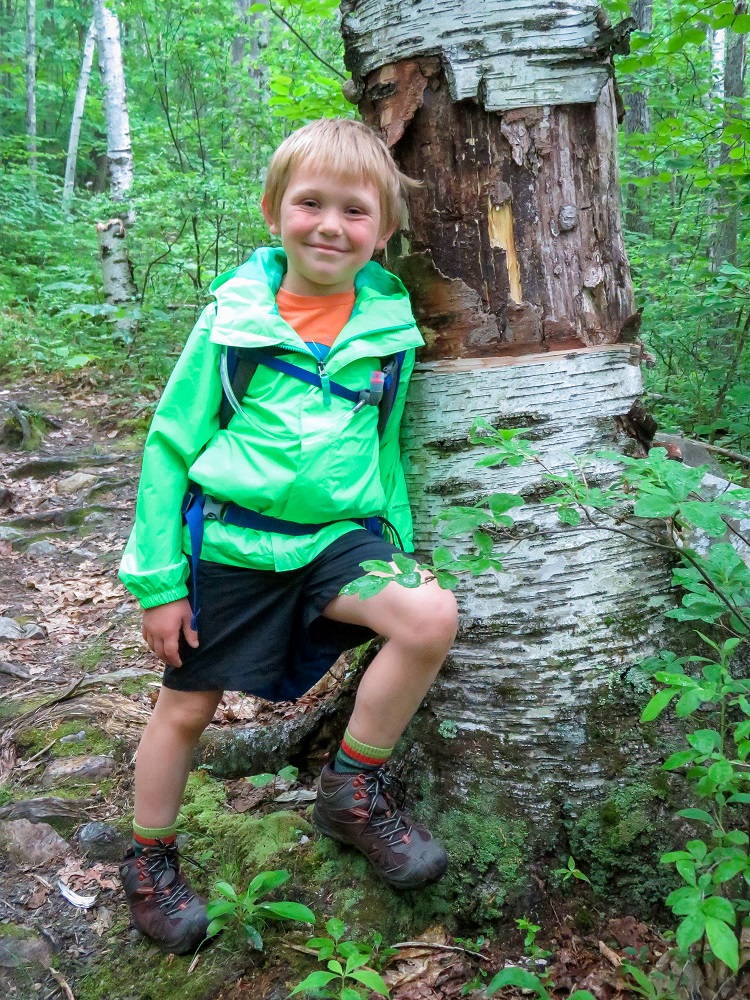
In 2016 my grandson Cyrus and I started section hiking the Long Trail. He was six. Reaching Canada in July, 2019, was the end of an epic journey that both of us will treasure for the rest of our lives.
Rock Hopper, a.k.a. Cy, found his trail name the first day out. We started from North Adams, Massachusetts, on a July day with mountain laurel in full bloom. I knew this section would tell me a lot about the next 272 miles, that I’d know by the end of the day whether Cy had the will and endurance to reach the northern terminus. But I really had little doubt.
I wondered how he would manage the first steep rockslide I remembered from my previous Long Trail hike—a real test of strength and stamina. He loved it! Scrambled and danced right up boulders, and asked me when the next slide was coming. He announced his trail name was now Rock Jumper, which evolved to Rock Hopper because, guess what? it sounded better.
Guess What! might have been a more fitting trail name. That, and questions like “Ya wanna know something?” were common conversation openers. There were lots of them: “Imagine a Matchbox car driving the Long Trail,” “How far to the next shelter?” and “What keeps the gas canister from blowing up?”
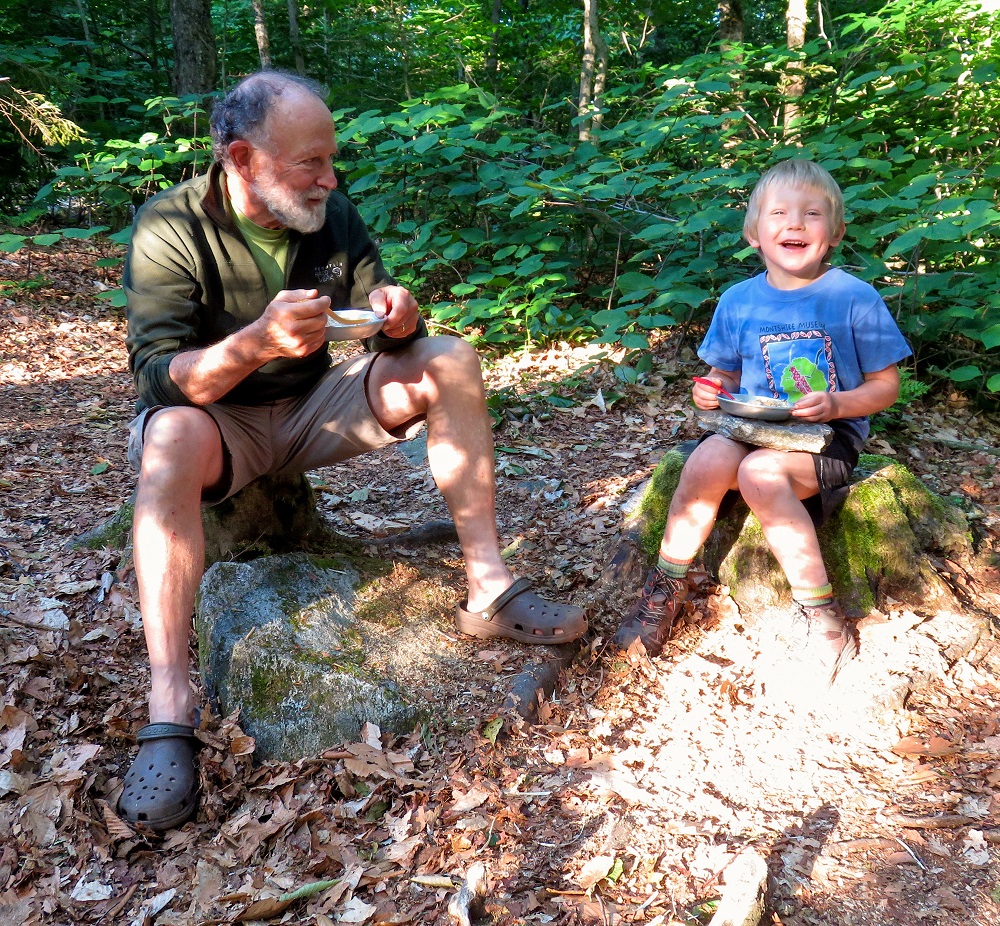
Cyrus is an active kid; we’ve had him hiking since he was three. He climbs trees, skis, rides his bike, hunts, and plays baseball. At two he used to look longingly through the screen door and plead, “Outside. Outside!” At six, he was game for this long walk. Since he has been steered away from the glowing temptations of TV, video games, and cell phones, he had none of those distractions to hold him back.
He’s a reader and loves a good story, and stories were essential to keep his mind going on long days on the trail. Early on, storytelling began with his questions: “What’s the funnest thing you’ve ever done? What is the story of your dad? What’s the story of your grandpa who lived in Montana?” He asked for stories from my childhood, then for made-up stories of the Civil War and stories of hunters. He taxed my imagination and mental energy.
To give my brain a rest on our next section hike, I suggested we tell stories together. I would present a chapter, then he would pick up the next. “Great idea, Grandpa!” By Chapter 4 he was talking 20 minutes to my five. Just as my chapter described two smokejumpers parachuting to save a family of campers from certain death by fire, he interrupted: “No, Grandpa, that’s not how it goes. It’s like this.” He returned the jumpers to the plane, and narrated another 20 minutes of the story.
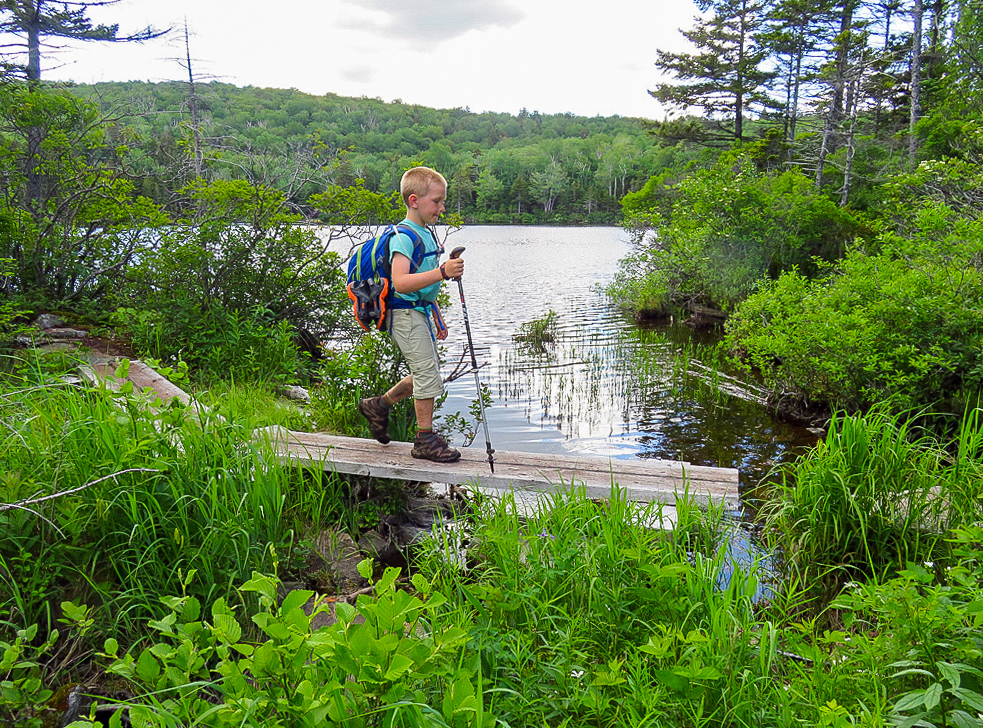
I have no doubt storytelling is what kept him going. As lovely as the Long Trail is, those miles of green can be boring for a kid. We developed first-person narratives, those games of pretend we all played as children. On a sweltering hot and humid day from Clarendon Shelter up Killington Peak to Cooper Lodge, I worried Rock Hopper might be overly challenged. But he was Indiana Jones and I was David Livingston, searching for the gateway to the Lost City, knowing full well we would find it by pressing a granite pebble in the back wall of the old stone lodge.
We were Larry and Bob, who located Goofus Johnson, lost off the Appalachian Trail for 30 years. We hiked home to Maine at the end of the Civil War as Union soldiers Colonel Joshua and Private Finnegan; we slashed through jungles in Vietnam as Captain Levi and Lieutenant Keith, Army medics trying to reach injured soldiers. We were Black Panther and Plastic Man; Native Americans; knights of the Round Table; Vermont homesteaders at the end of the French and Indian War. We told tales of a haunted Colorado mining town, and the story of two World War II soldiers who discover and befriend a family of yeti in the Swiss Alps.
It wasn’t all fiction, this storytelling. In preparation, I read up on the Patch Hollow Massacre of 1831, a wild tale of vigilante injustice and accidental murder in a tiny vanished settlement on the trail above Shrewsbury. I researched stories of strange disappearances on Glastenbury Mountain.
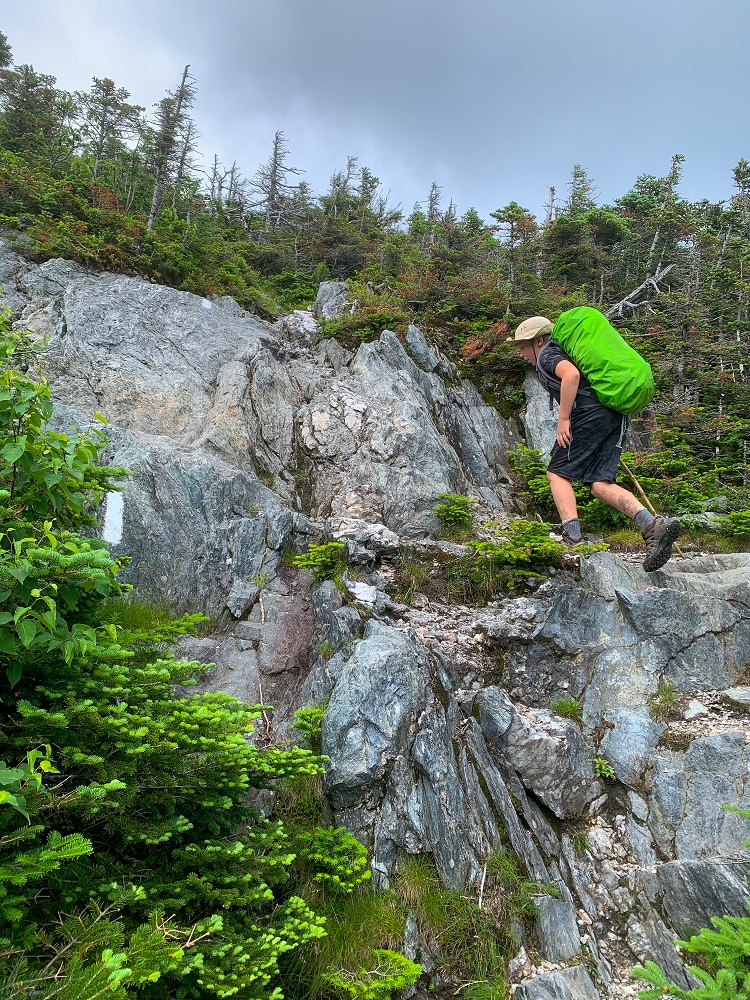
Parents and grandparents know there is one brief hour when you are no longer slowing your stride to keep a kid with you, when you hike side by side at your own right pace. When that hour is suddenly over, you’re the one straining to keep up. Cy beat a steady pace up Jay Peak with few breaks. When we entered the sub-alpine zone, rich with the smell of spruce and balsam fir, he paused for a moment and said, “This is beautiful, Grandpa!” Then he launched ahead, and when we broke out onto the ski slope below the rocks and krummholz of the top, he ran, scrambling up the rocks, and I couldn’t catch him.
We loved collecting trail names: Miss Step, Merlin and his little dog Monkey, Yonder, Oops, Sunnyside, Boogie Pilgrim, and many others. We trail-named mountains, too. Belvidere became Mount Velvet Ears. Haystack was Mount Moose Poo.
Rock Hopper proved early on that he could hike 10- and even 13-mile days. But I wondered about his emotional strength, knowing it’s not always easy for a kid that young to be away from home and parents. There were a few upsets, but they didn’t last long. His father joined us at the Inn at Long Trail for a night, and hiked five miles with us the next day. The goodbye was tearful, but Rock Hopper left it behind when we became Levi the Logger and Olaf the Forester walking a stand of big timber. At night he had his Purple Bunny stuffy for comfort.
One morning as we were packing to leave Greenwall Shelter, Rock Hopper came to me quite upset because he’d lost a bag of jelly beans his mother had given him. She had told him to think of her every time he ate one. Not only were the treats missing, he also had lost the precious charms that connected him to his mother. We found an empty plastic bag. A bad sign. Chipmunks! He cried a bit more, but after one last sniffle moved on. A few hours up the trail, Cy stopped and said he’d thought of one more place to look. He took off his pack and checked the side pocket under his copy of Hatchet. There they were! Big smiles and jellybeans all around.
Rock Hopper had a good eye for wood frogs, maybe because he is closer to the ground than I and has younger eyes. Whenever he saw a red eft, he carefully picked it up and set it off to the side, safe from the feet of inattentive hikers.
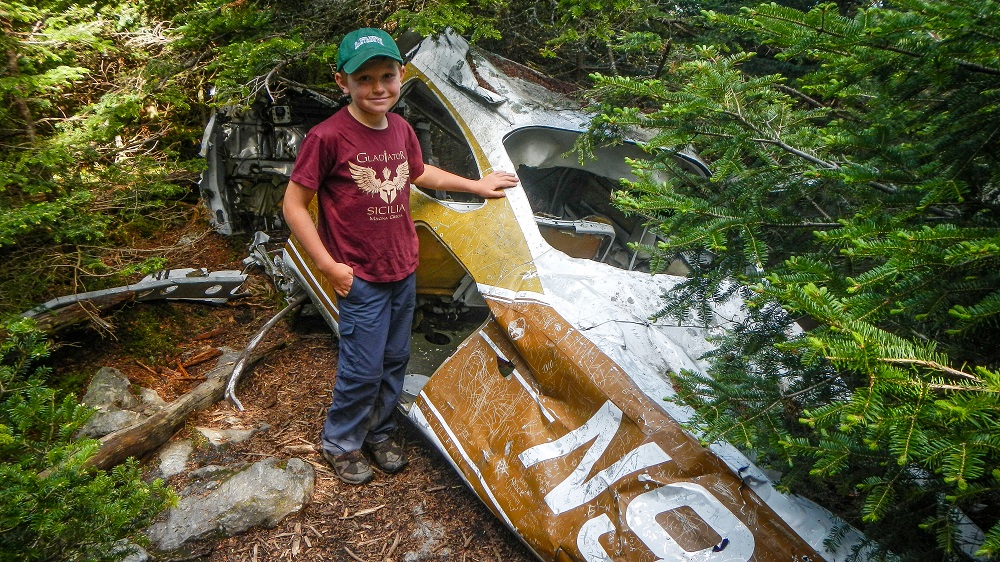
Mt. Abraham was his first 4000-footer, and his first time above tree line. He was elated, but he was equally impressed by the 1973 wreckage of a small airplane just north of the peak. I had done some research, so I could tell him the story of this small plane lost in the clouds, skimming through the treetops and crashing. The pilot and his two friends, uninjured, found the Long trail 100 feet from the site and walked out. We later detoured on our way up Camel’s Hump to see the wreckage of the World War II B-24 that crashed on a training mission in 1944. This story was sadder: only one of ten men aboard survived, rescued by high school members of the Civil Air Patrol in Waterbury.
Rock Hopper delighted in scrambling up the rock faces of Camel’s Hump and the ladders and stones of Mansfield. He dove into deep pools in the Mill River in Clarendon Gorge, and climbed the fire tower on Belvidere twice. We panned for gold. We watched a snake swallowing a tiny frog, the little hopper’s legs poking out of the snake’s mouth. When Cy saw “0.3 Miles” on a trail sign, he asked how far, introducing a good lesson in decimals. His energy was limitless: after a 13-mile walk to David Logan Shelter, he was climbing the shelter frame and swinging from the rafters.
His baseball skills came in handy when hanging bear bags. I must have tried ten times to toss a stick tied to a cord over a limb when he asked to give it a try. His first throw put it right over the branch. His closest approach to serious injury was when someone sharing Corliss Shelter tried to hang a line tied to a small bag of sharp rocks. Her underhand was so wild the bag of rocks came down on Cy’s back, just missing his head, and slid off, fortunately without harm. “Let me give it a try,” Cy said. He had the cord up and over the limb on his first try. Our trail name for her was Watch Out.
On day seven of our final section, from Laura Woodard Shelter, Rock Hopper’s mother walked in from Journey’s End to meet us with a pack full of fresh fruit and sandwiches. Cy had been expecting her all day at every turn of the trail. Such an embrace when those two met! And she was there to see her Rock Hopper stand by the obelisk marking the Canadian border and the end of the Long Trail.
“Grandpa, every time I look up, I expect to see green,” Cy had said earlier that day. That reminded me of his response to the view from Mt. Horrid’s Great Cliff: “How green does it get?” The list is long of the bounties a child—or anyone—gains from walking those miles in such a green world, scrambling up rocks, swimming the mountain lakes, bathing in streams, hiking in the rain—just living in the woods, off and on, for 30 days. If Rock Hopper is like me, those moments will shape his dreams for years to come. And I have a hiking partner for life.
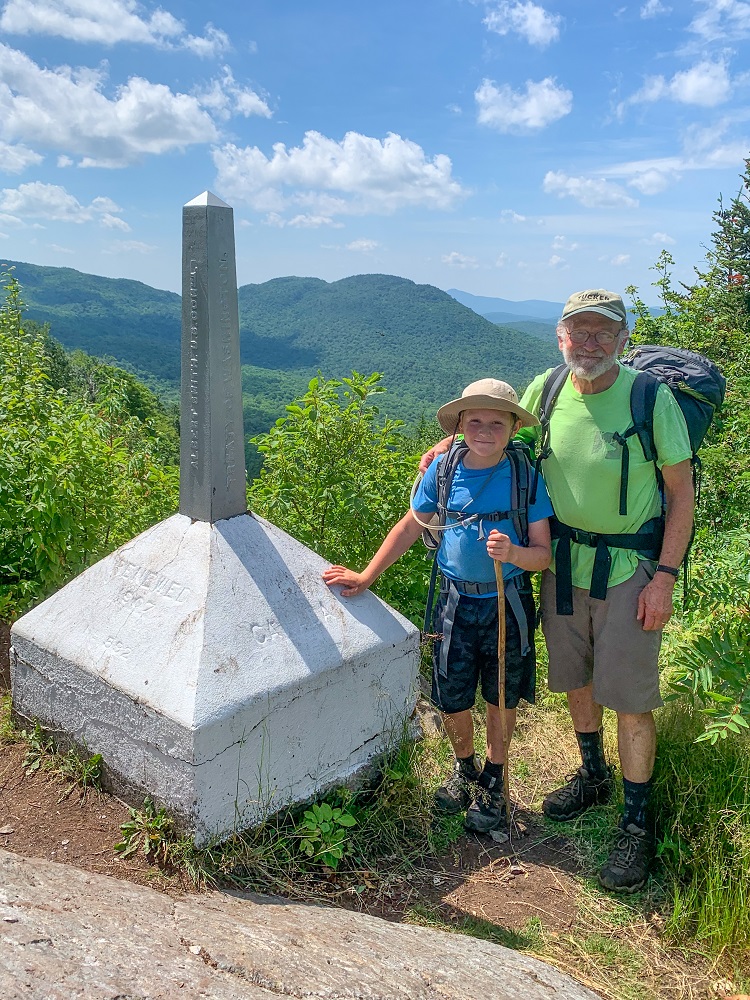
Tips on Hiking the Long Trail with a Child
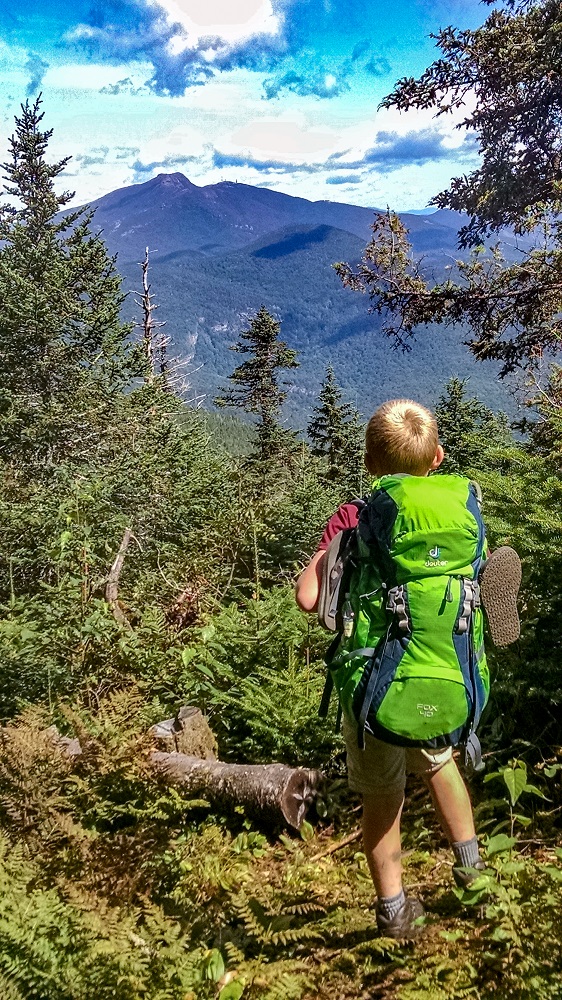
Trust a child’s ability. I gave Rock Hopper a lesson or two about fall avoidance, pointing out how to safely navigate roots, slippery rocks, and mud. Then I let him learn, let him make his own mistakes, only observing for safety. Cy learned to pick his own way, and it often was a better choice than mine, or a better choice for his short legs. If his way was different, it didn’t make him wrong. I didn’t nag or criticize. He rarely stumbled, and almost never fell.
Encourage; don’t nag. Experienced hikers trying to make time boost their strides and tempo on a flat or smooth stretch of trail, no matter how short. Kids don’t always think of that. Rather than telling Cy to ‘step it up’ or ‘move along faster now,’ I’d comment on the trail condition, avoiding the nag. “Wow, this piece of trail is sure built for speed,” or, “Here’s an easy stretch of trail.” He never failed to take the initiative to step it up.
Set reasonable goals. We started with seven- to eight-mile days, and worked up to 10 to 13 miles with an occasional eight-mile day to relax.
Take breaks. Some short, some long, always with snacks. I could tell when Rock Hopper needed a break, and when I could push him a bit. At first we established a schedule of a break every half hour with a long break every two hours.
It doesn’t have to be a marathon. We hiked seven sections in four years: two trips per summer with one 65-mile trip the final year, working around summer camp, baseball, and family travel.
Meet new people. I started conversations with fellow hikers to break the ice for Rock Hopper, then he took over.
Keep the weight down. When he was six and seven, I carried most of the weight. He had less than ten pounds in his small day pack. At eight and nine, he carried a child’s backpack with loads of 15 to 17 pounds.
Hydrate. He liked his “Woobie,” as he called his hydration bladder, and always drank plenty of water.
Keep their minds active. Have a storehouse of stories. I researched the two plane wrecks along the trail, The Patch Hollow Massacre, and the mystery of Glastenbury Mountain. Stories of all kinds got Rock Hopper to Canada—family stories, Bible stories, Greek myths, role-playing. We carried a lightweight paperback, a deck of cards, and a journal for camp time, and he could easily spend two hours building fairy houses of sticks, bark, moss, and stones.
Keep a journal. It’s a rare privilege to pass the Long Trail experience on to a new generation. You won’t want to forget the precious miles you walk with a kid like Rock Hopper. Treasure the time.
Bonus: Find more tips for hiking with kids here.



















This article about Rock Hopper and his grandfather is delightful! Thank you
Adorable! So inspiring too!